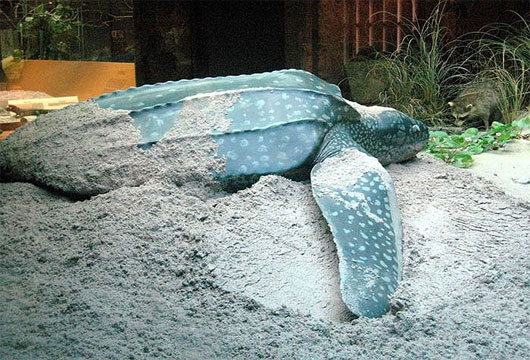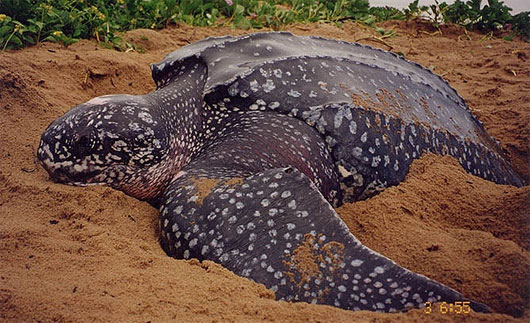Unknown story about giant turtle, weighing nearly 1 ton
Sea turtle Dermochelys coriacea, known as the largest turtle on the planet.
They are also known as leather turtles , because the distinctive characteristics of this turtle are no tomorrow. Their backs are covered with a thick, tough skin. Giant tortoise Dermochelys coriacea is the only species remaining in the family Dermochelyidae.

Another special feature is that they don't have teeth. They only have a layer of sharp horns attached to the upper lip and the ingrown spines in the throat, helping them swallow food easily. This is a species capable of diving deep records. They often swim, feed and rest at a depth of 1,200m on the seabed. They stopped breathing for 70 minutes on the sea floor.
People with the motto "slow like turtles" , but, for this turtle to be reconsidered, because the movement speed of Dermochelys turtle coriacea is terrible, with 35.28 km / hour, or nearly 10m / s in Water Environment. According to scientists, the reason that this turtle has a tremendous swimming speed like that because they have big, wide, extremely strong flippers.

Dermochelys coriacea mature to 2m, even 3m. Body weight from 250 to 700kg. The largest turtle known to be 3m long, weighs 916kg, was discovered in the West Wales sea.
The activity intensity of Dermochelys tortoises coriacea is considered to be no rival. They only use about 0.1% of their time to rest. Thus, it can be said, regardless of day or night, rough or quiet, this turtle is operating at high speed.
This powerful, terrible movement keeps them in a high, stable body temperature and especially creates extremely powerful muscle systems.
The Dermochelys turtle species coriacea is widely distributed. They are present from Alaska to Norway from the Cape of Good Hope in Africa to the southernmost point of New Zealand. They live in all tropical and subtropical waters, and are also found in the Arctic Circle.

Although their main life time is offshore, deep waters, scientists sometimes encounter them on land, or shallow waters.
Scientists tracked a turtle by attaching a positioning device on their backs. Surprisingly, the turtle swam from Indonesia to the US for about 20,000km in 647 days while he was searching for food.
The mating process takes place in the sea. Male turtles have never landed since they hatched from terrestrial eggs. The special thing is that females only mate for a period of 2-3 years, but they make their nest and reproduce regularly. Each female usually mate with several males consecutively. Male turtles in addition to mating, there is no role.

Female turtles often find soft, soft sand, use their front legs to deepen, lay eggs in the pits, and then fill up sand. They usually lay up to 9, each 9 days apart. Each drive has 110 eggs. Thus, a birth, they produce nearly 1,000 eggs. Up to 85% of eggs hatch into baby turtles. However, the number of baby turtles that survive until maturity is extremely small. They face numerous dangers lurking since they hatch out of eggs.
When baby turtles get into the sea, people rarely see them. They stay in the deep sea to feed until adulthood, back to the sand to give birth.
Dermochelys turtles' favorite food coriacea is jellyfish. They often migrate between cold waters, where many jellyfish live.

Scientists claim that Dermochelys coriacea has existed in some form since sea turtles appeared 110 million years ago in the Cretaceous period. They are quite closely related to the Cheloniidae. They are the only surviving species in the genus Dermochelys.
Recent research shows that there are about 26,000 to 43,000 female turtles each year, much less than 115,000 individuals according to the 1980 study. This decline is worth warning for the survival of Dermochelys tortoise coriacea in future.
- Catching 'descendants' of Ho Guom Turtle?
- The thrilling story of the giant turtle attacking the buffalo in the middle of the Red River
- Giant tortoise took over the position of mother at the age of 80
- The untold story about the turtle skeleton in Yen Bai and Hoa Binh
- Discover the oldest turtle fossil in the world
- Giant snakehead sea turtle
- 13 facts about turtles that few people know about
- The most famous turtle in the world has passed away
- Discover the unknown about the world's largest tortoise turtle
- Japan discovered 70 million-year-old fossil turtle
- Monsters themselves turtles, strange bird heads of Vietnam
- Catch huge pythons weighing 100kg
 Surprised: Fish that live in the dark ocean still see colors
Surprised: Fish that live in the dark ocean still see colors Japan suddenly caught the creature that caused the earthquake in the legend
Japan suddenly caught the creature that caused the earthquake in the legend A series of gray whale carcasses washed ashore on California's coast
A series of gray whale carcasses washed ashore on California's coast Compare the size of shark species in the world
Compare the size of shark species in the world